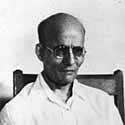|

|
Alphabetical Order
|

|
|
|
 Born in a middle-class Chitpavan Brahmin family in a village near Nasik, Savarkar was a product of Maharashtra's political and cultural resurgence in which M.G. Ranade, Gopal Krishna Gokhale and Lokmanya Tilak played a vital role. In 1906, Savarkar sailed for England on Tilak's recommendation. While there, he wrote on bomb-making and, in 1910, was tried by a special tribunal for treason and abetting the murder of the collector of Nasik. Unlike Gandhiji and Nehruji who were given Class A prisoner status, Savarkar was given Class C and was made to drive an oil mill. He had to make mulch coir and make ropes out of it with bare hands. Even in prison forcible conversions of poor Hindus to Islam were taking place. Savarkar fought for the prison reforms and put a stop to these conversions. He eliminated untouchability among Hindu prisoners in the Andamans.
Born in a middle-class Chitpavan Brahmin family in a village near Nasik, Savarkar was a product of Maharashtra's political and cultural resurgence in which M.G. Ranade, Gopal Krishna Gokhale and Lokmanya Tilak played a vital role. In 1906, Savarkar sailed for England on Tilak's recommendation. While there, he wrote on bomb-making and, in 1910, was tried by a special tribunal for treason and abetting the murder of the collector of Nasik. Unlike Gandhiji and Nehruji who were given Class A prisoner status, Savarkar was given Class C and was made to drive an oil mill. He had to make mulch coir and make ropes out of it with bare hands. Even in prison forcible conversions of poor Hindus to Islam were taking place. Savarkar fought for the prison reforms and put a stop to these conversions. He eliminated untouchability among Hindu prisoners in the Andamans.
After the arrest of his brother, who also was given a life term in Andamans, and banning of his books in 1909, the British confiscated all his family's personal property. The utensils, clothes were thrown out on the street. His family's belongings were nothing but the clothes they were wearing at the time. All this while he was in Europe. This victimization of his family made him return to London where he was arrested.
However, Savarkar is best known for his work on Hindutva, which advanced the thesis that the Hindus were a nation. Indeed, Rashtriya Swayamsevak Sangh (RSS) founder Keshav Baliram Hedgewar relied on this hand-written manuscript to develop the intellectual foundations of his organisation.
The central proposition of Savarkar's thesis was that Hindus were the indigenous people of the sub-continent and formed a single national group despite the obvious social, linguistic and religious differences. Savarkar was elected president of the Hindu Mahasabha in 1937. After Hedgewar's death in 1940, relations soured between the Mahasabha and the RSS. In fact, Savarkar regarded Madhav Golwalkar as an adversary. Savarkar's followers, among whom was Gandhi's assassin Nathuram Godse, considered him the driving force behind the Hindu unification movement.
|




 Born in a middle-class Chitpavan Brahmin family in a village near Nasik, Savarkar was a product of Maharashtra's political and cultural resurgence in which M.G. Ranade, Gopal Krishna Gokhale and Lokmanya Tilak played a vital role. In 1906, Savarkar sailed for England on Tilak's recommendation. While there, he wrote on bomb-making and, in 1910, was tried by a special tribunal for treason and abetting the murder of the collector of Nasik. Unlike Gandhiji and Nehruji who were given Class A prisoner status, Savarkar was given Class C and was made to drive an oil mill. He had to make mulch coir and make ropes out of it with bare hands. Even in prison forcible conversions of poor Hindus to Islam were taking place. Savarkar fought for the prison reforms and put a stop to these conversions. He eliminated untouchability among Hindu prisoners in the Andamans.
Born in a middle-class Chitpavan Brahmin family in a village near Nasik, Savarkar was a product of Maharashtra's political and cultural resurgence in which M.G. Ranade, Gopal Krishna Gokhale and Lokmanya Tilak played a vital role. In 1906, Savarkar sailed for England on Tilak's recommendation. While there, he wrote on bomb-making and, in 1910, was tried by a special tribunal for treason and abetting the murder of the collector of Nasik. Unlike Gandhiji and Nehruji who were given Class A prisoner status, Savarkar was given Class C and was made to drive an oil mill. He had to make mulch coir and make ropes out of it with bare hands. Even in prison forcible conversions of poor Hindus to Islam were taking place. Savarkar fought for the prison reforms and put a stop to these conversions. He eliminated untouchability among Hindu prisoners in the Andamans.